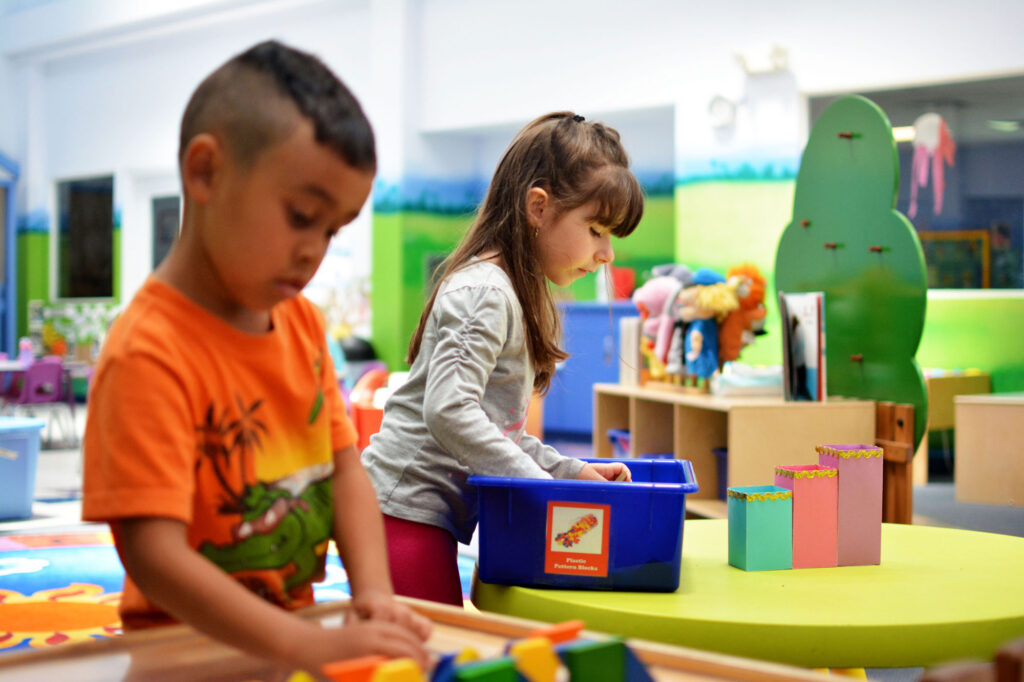
10 Ways to Support Creativity
Creative world school Jan 4, 2022Creativity isn’t just about music, drama, and visual arts – it also involves skills like problem-solving, questioning, and a love of learning. Here are 10 ways you can support creativity in your child:
1. Problem Solving
Present a problem and ask your child to help you solve it.
Example: If you have a wobbly table ask your child to help you determine which leg is shorter and how to support it to make it stable.
Development: Problem-solving activities foster children’s critical thinking skills.
Model: As you come across small problems throughout your day, like a jar that is difficult to open, verbalize your thought process as you try different techniques to solve the problem. This helps children understand the importance of trial and error when solving problems.
2. Explain their Thinking
Ask your child to explain why they made certain decisions or actions.
Example: Ask them why they can’t put their shoes on before their pants. What might happen if they do?
Development: Verbalizing their thought process supports children’s language skills and makes them more conscious of their decisions.
Model: Explaining your thinking helps increase children’s vocabulary and understanding of the how and why of common processes. This should be done with children of all ages. Infants and toddlers greatly benefit from hearing people talk through their actions, “We’re almost ready to go, I just need to grab the diaper bag. I better check to make sure we have enough diapers before we leave.”
3. Open-Ended Materials
Provide your child with open-ended materials that they can use in a variety of ways.
Example: Provide them with loose building blocks instead of kits designed to create specific objects and sketchbooks instead of coloring books.
Development: Open-ended materials offer children possibilities that are only limited by their imagination.
Model: When playing with your child, tap into your creativity. A piece of string can be used as a measuring tool, hair, an animal’s tail, a mustache, a snail’s spiral shell, etc.
4. Free Time
Carve out free time. Allow your child opportunities to choose how they wish to spend their time.
Example: Start Sunday mornings by encouraging some quiet playtime. Sometimes you might join their play, but also encourage their independent play as well.
Development: Free time allows children space to quiet their minds and self-regulate, which is vital to learning how to handle their emotions.
Model: Take time for yourself as well. Everyone needs time and space to recharge over the weekend. By spending time reading, exercising, or meditating you are showing your child that you value self-care.
5. Allow Boredom
Boredom provides opportunities to wonder and be creative.
Example: If your child says, “I’m bored!”, reply with, “It sounds like you have an opportunity to try something you’ve always wanted to do.”
Development: Boredom helps children discover their individual interests and build confidence in their abilities.
Model: Help your child think through how they want to spend their time. “What’s something you’ve always wondered about? What is something you’d like to try? What is something you’ve always wanted to make?” While you want to encourage their independence, they will still need supervision and support to bring their ideas to life.
6. Explore the Outdoors
Bugs, dirt, plants, and the sky offer so many opportunities to explore.
Example: Lay outside with your child to see how many shapes you can see in the clouds. Take magnifying glasses outside and look closely to see what you can discover.
Development: Time outside helps you and your child calm your mind and relieves stress.
Model: Spend time outside as a family. Take walks, notice the details in nature, appreciate the trees and animals you see. This helps to show your children the value of our natural world.
7. Let them Wonder
Don’t answer all your child’s questions. Encourage them to work with you to discover the answers to their own questions.
Example: If your child asks why the sky is blue, help them to read and research the answer, then perform a science experiment to better understand their discovery.
Development: By working with them to find the answers, your child will see you as a partner in their learning process. The cognitive skills required in developing questions and finding answers are essential to becoming an engaged citizen.
Model: We all use books and the internet daily to research our own questions. Verbalize your question and talk through how you are posing the question in your search. If appropriate, have your child sit with you as you review the results. Talk through why you are bypassing some results (they are tied to adds or are opinion pieces) and why other results are valid.
8. Encourage the Why
As mentioned above, you want to encourage children to find their own answers, but you still want to encourage your child to ask those questions.
Example: Choose a consistent time to ask your child about their day. Ask them if they have any questions or wonderings. Record these in a notebook so that you can revisit them later.
Development: Asking questions and discovering answers helps children to increase their understanding of the wider world. With each new piece of information, a child’s brain adjusts their previous assumptions and forms new neural connections.
Model: Forming effective questions is a skill. Verbalize how you turn your wonderings into questions. “I want to know why bees make a buzzing sound when they fly. I could ask Siri, “Why do bees make a buzzing sound when they fly?”
9. Decision Making
Encourage your child to help you with decision making throughout the day.
Example: What to have for dinner is the never-ending question. Have your child help make that decision by presenting them with two vegetable options and asking them which they would prefer.
Development: Children can get overwhelmed when presented with multiple options, helping them narrow the options, and then deciding are essential skills.
Model: Talk through how you narrow your options and make decisions. When at the grocery store, discuss all the different cereal options. Talk about how you want a healthy cereal without a lot of sugar, so you will choose between options x, y, z. Then explain why you are making your specific decision.
10. Offer Scenarios
Playing “What would you do?” helps children to be prepared when they encounter difficult situations.
Example: Ask questions like, “What would you do if someone took the crayon you wanted? What would you do if someone said they didn’t want to play with you?” As your child grows and might encounter increasingly difficult situations these questions can change to prepare them for those situations.
Development: When people become upset, their brains can revert to a flight or fight response. Frequently talking about how to handle emotional situations can help your child make thoughtful rather than hasty decisions because they already know their answer.
Model: Encourage your child to ask you these questions as well, answering them thoughtfully and honestly. Remember, there are no right or wrong answers to “What would you do?” questions. You can help your child contemplate alternatives by saying, “That is one way to respond. I think I might…”, “What else could you say/do?”, “How can you let them know how you feel?”, etc.



